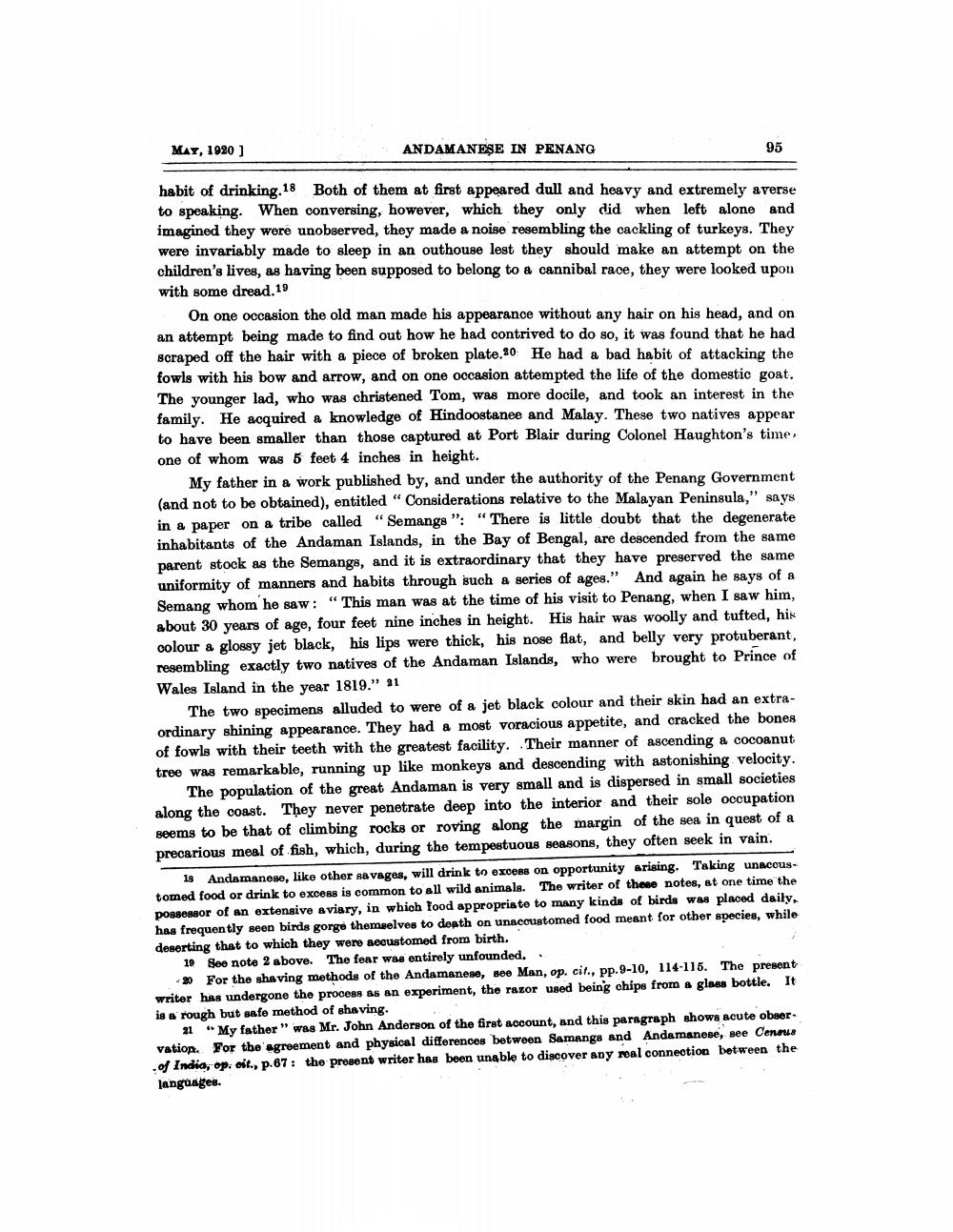________________
MAY, 1920 ]
ANDAMANESE IN PENANG
95
habit of drinking.18 Both of them at first appeared dull and heavy and extremely averse to speaking. When conversing, however, which they only did when left alone and imagined they were unobserved, they made a noise resembling the cackling of turkeys. They were invariably made to sleep in an outhouse lest they should make an attempt on the children's lives, as having been supposed to belong to a cannibal race, they were looked upon with some dread. 19
On one occasion the old man made his appearance without any hair on his head, and on an attempt being made to find out how he had contrived to do so, it was found that he had scraped off the hair with a piece of broken plate.30 He had a bad habit of attacking the fowls with his bow and arrow, and on one occasion attempted the life of the domestic goat. The younger lad, who was christened Tom, was more docile, and took an interest in the family. He acquired a knowledge of Hindoostanee and Malay. These two natives appear to have been smaller than those captured at Port Blair during Colonel Haughton's time, one of whom was 5 feet 4 inches in height.
My father in a work published by, and under the authority of the Penang Government (and not to be obtained), entitled “ Considerations relative to the Malayan Peninsula," says in a paper on a tribe called "Semangs": " There is little doubt that the degenerate inhabitants of the Andaman Islands, in the Bay of Bengal, are descended from the same parent stock as the Semangs, and it is extraordinary that they have preserved the same uniformity of manners and habits through such a series of ages." And again he says of a Semang whom he saw: “This man was at the time of his visit to Penang, when I saw him, about 30 years of age, four feet nine inches in height. His hair was woolly and tufted, his colour a glossy jet black, his lips were thick, his nose flat, and belly very protuberant, resembling exactly two natives of the Andaman Islands, who were brought to Prince of Wales Island in the year 1819." 31
The two specimens alluded to were of a jet black colour and their skin had an extraordinary shining appearance. They had a most voracious appetite, and cracked the bones of fowls with their teeth with the greatest facility. Their manner of ascending a cocoanut tree was remarkable, running up like monkeys and descending with astonishing velocity.
The population of the great Andaman is very small and is dispersed in small societies along the coast. They never penetrate deep into the interior and their sole occupation seems to be that of climbing rocks or roving along the margin of the sea in quest of a precarious meal of fish, which, during the tempestuous seasons, they often seek in vain.
18 Andamanese, like other savages, will drink to excele on opportunity arising. Taking unacous. tomed food or drink to excess is common to all wild animals. The writer of these notes, at one time the possessor of an extensive aviary, in which food appropriate to many kinds of birds was placed daily, has frequently seen birds gorge themselves to death on unaccustomed food meant for other species, while deserting that to which they were accustomed from birth.
19 See note 2 above. The fear was entirely unfounded,
20 For the shaving methods of the Andamanese, Bee Man, op. cit., pp. 9-10, 114-115. The present writer has undergone the process as an experiment, the razor used being chips from a glass bottle. It is a rough but safe method of shaving.
21 "My father" was Mr. John Anderson of the first account, and this paragraph shows acute observation. For the agreement and physical differences between Samangs and Andamanese, see Census of India, op. oit., p.67: the present writer has been unable to discover any real connection between the languages.




